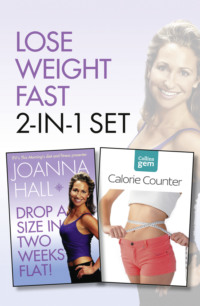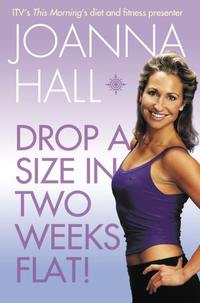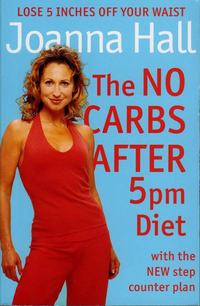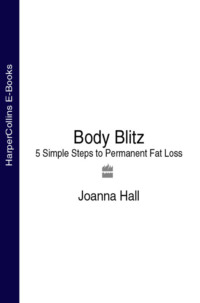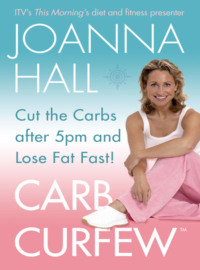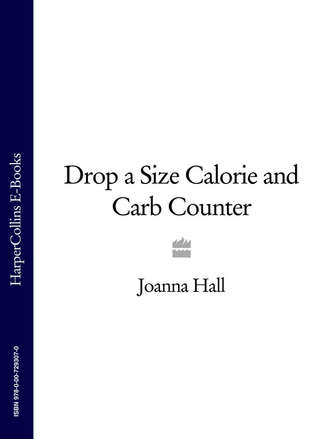
Полная версия
Drop a Size Calorie and Carb Counter

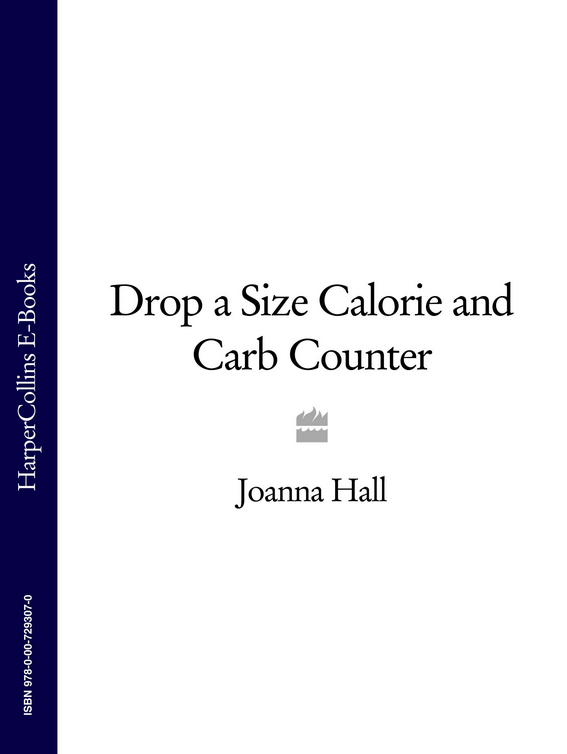
The UK's No.1 DIET and FITNESS EXPERT
Joanna Hall MSc
DROP
A SIZE
CALORIE
and
CARB
counter

Table of Contents
How to Use this Book
Introduction
Section One - The Carb Curfew Plan
Carb Curfew - How It Came About
The Plan
Weight Loss Basics
Food Groups
Be Your Own Carb Curfew Coach
Exercise
Guide to Vitamins and Minerals
Section Two - Basic and Generic Food
Cereals and Cereal-based Foods
Biscuits (savoury and sweet)
Breads
Cakes (large)
Cakes (small)
Cereals (grains)
Cereals (packet)
Desserts (cereal-based)
Flours and starches
Pasta and noodles
Pastries (sweet and savoury)
Dairy Products
Cheese
Cream
Desserts (dairy-based)
Eggs
Milk
Sauces (dairy-based)
Spreads
Yoghurt
Fish and Seafood
Fish
Oily fish
Seafood
Fruit and Nuts
Fruit (fresh, dried and canned)
Fruit juices
Nuts and seeds
Meat, Poultry and Game
Meat
Offal
Poultry and game
Miscellaneous
Everyday store cupboard items
Drinks (alcoholic)
Vegetables and Pulses
Potatoes and potato products
Pulses, beans and lentils
Vegetables
Section Three - Brand Name Foods
Biscuits, breads, cakes and other baked goods
Cereals
Cheese, cream, milk and yoghurt
Crackers, crisps, snacks and snack bars
Desserts and ice cream
Drinks
Eating out and fast food
Fish and seafood
Meat products
Poultry products
Ready meals and side dishes
Sandwiches
Sauces, dips and dressings
Soups
Spreads
Sweets and chocolate
Vegetable products
Vegetarian foods
Other Titles by the Same Author
Copyright
About the Publisher
HOW TO USE THIS BOOK
The Drop a Size Calorie and Carb Counter has been split into three sections to make it simple and easy to use.
Section One: The Carb Curfew Plan outlines the principles of the Carb Curfew – my easy-to-use strategy for achieving and maintaining weight loss. It also features plenty of tips and pointers on improving your health whilst you achieve your fat loss goals.
Section Two: Basic and Generic Foods details not only the calorie value of basic foods, but also their protein, carbohydrate, fat, fibre and sodium contents. Included in this section are the basic ingredients of meals – for instance rice, vegetables, meat and poultry and so on – as well as store cupboard ingredients and various other everyday foods. You will find the values for both raw and cooked ingredients, so you can analyse recipes and cooking favourites. Where popular, widely available dishes are featured, such as a one-crust apple pie, the values given are averages.
Section Three: Brand Name Foods features branded foods – the supermarket favourites, specialist ranges and processed convenience foods that may be a regular feature in your shopping basket. I've included the nutritional breakdown as the standard ‘per 100 gram’ and ‘per serving’; just as you would find on food labels. Since even a basic product, like bread, can vary in the amount of carbohydrate or fat it contains, I have included a variety of different manufacturers. The nutritional value of two brands can be surprisingly different and, as consumers, we can be quite particular about our favourite brand of foods. While I have tried to include as many products as possible, there are bound to be some foods that you regularly eat that are not listed. So to help you judge for yourself how healthy these are, section one includes information on how to decipher food labels.
All the foods featured are categorized and listed alphabetically so in order to find a particular food, first decide if it a generic food such as chicken or a branded item such as Sweet Chilli Chicken Fillets by Waitrose then simply look up the relevant category from the list of contents on pages v–vii.
In total, I have detailed the overall calorie value and macronutrient content of over 5000 foods. However, while vitamins and minerals are vital components in our daily diet, I have not included the proportions of vitamins and minerals found in these foods in this book – it would simply have been too big! While they provide no direct energy to the body in the form of calories, vitamins and minerals do have a very important role to play in the health of your body. To help ensure you are getting an adequate supply of vitamins and minerals, check out the guide on page 53. This quick reference table will help you see the benefits fruits, vegetables and other foods provide for your body. It's important to bear in mind that food doesn't just provide the calories to get us through the day, but can directly affect our health, looks and energy.
The following notes will help you get the most accurate information from the book.
1 Food items listed in the Basic and Generic Foods section are listed ‘per 100g’. Sodium is listed in milligrams. All other listings are in grams.
2 Food items in the Brand Name Foods section are listed ‘per serving’ and ‘per 100g’. For each item, the figures are given ‘per serving/per 100g’. The categories are clearly given at the top of each column on every page.
3 You can find restaurant and fast food meals in Eating Out and Fast Food in Section Three. Sandwiches are listed separately in Section Three.
Abbreviations
Brand Foods:
COU = Marks & Spencer Count on Us
TTD = Sainsbury's Taste the Difference
BGTY = Sainsbury's Be Good to Yourself
GFY = Asda Good for You
In the nutritional tables:
N = negligible tbsp = tablespoon Tr = trace tsp = teaspoonINTRODUCTION
Hello, and welcome to my Drop a Size Calorie and Carb Counter. I am always being asked about the calorie value of different foods and what the best foods are for Carb Curfew suppers – so I've put everything you need to know in one place. The idea is not to overwhelm you with lots of different figures, but to give you concise information, whether you want to lose weight or just stay within a healthy weight range.
Traditionally, calorie-counting books are used as a way of helping us monitor the amount of energy we are getting from our food and drink. To lose weight, the number of calories you eat has to be fewer than the number of calories your body burns off through exercise and your daily activities. But it's not all about numbers: eating the right type of nutrients can increase your energy levels and maximize health. Unfortunately, we often forget this in our efforts to keep weight under control and, as a result, we opt for low calorie but nutritionally poor foods. Even though your first motivation for picking up this book may be to help you count and cut calories, you'll soon find the information helps you realize your weight loss goals and improve your health, by enabling you to make wiser food choices. For example, you'll learn that energy-dense foods such as fats, and specifically saturated fats, are associated with an increased risk of heart disease, while nutritionally poor foods, such as processed, carbohydrate-rich foods that are high in sugar, can play havoc with your blood sugar levels and energy levels, and foods high in salt can affect your blood pressure.
This little book isn't just about counting calories for weight loss, but about counting your carbs and being aware of the nutrients required for a healthy body, too! So as well as lots of weight management tips, you'll also find plenty of health tips too. This calorie and carb counter is an invaluable companion to any weight loss programme but it will be especially useful for those following my Carb Curfew plan. It has been fascinating researching all the material and has been a real eye opener for me, too.

CARB CURFEW - HOW IT CAME ABOUT
As a weight management specialist, my studies and expertise led me to work with individuals and organizations in the United States, Australia and in the UK. During my travels, I became increasingly aware that many people out there were putting a lot of effort into reaching their weight loss goals, but their hard work appeared to be going un-rewarded. The scales were not moving in the right direction, their clothes were not feeling looser and their energy levels were not as high as they should be – but most galling of all, they were experiencing all of this while putting their real lives on hold! Yes, they were following recognized dietary advice to cut fat intake as a means of reducing overall calorie intake, and they were taking some physical exercise, but instead of feeling trimmer, lighter and full of energy, they didn't seem to be reaping the benefits.
What I began to realize, as I researched my Master's degree in sports science, was that following a low-fat diet wasn't the sole solution to weight loss. Yes, sticking to a low fat intake is still sensible dietary advice – one gram of fat alone provides 9 calories (the equivalent of nearly 45 calories per teaspoon) – but my studies have shown that for successful weight loss, you need to address your total calorie intake plus the proportion of carbohydrates and protein you are eating. Reducing fat alone won't work. What's more, my research revealed that people who were cutting the amount of fat in their diets were compensating for the ‘loss’ by filling up on ‘non’ or ‘low-fat’ starchy carbohydrates such as bread, pasta, rice, potatoes and cereal. This meant, quite simply, that while their fat intake was going down, their overall calorie intake was going up. A recent study from the centre for disease control and prevention reported a 22 per cent jump in the calories we consumed between 1971 and 2000. This increase in calories was directly attributed to increased carbohydrate intake despite a reduction in the percentage of fat we consumed over the same period. It seems people are eating more ‘non-fat’ starches under the misapprehension that because these starches contained little or no fat this automatically translates into little or no calories! This is what motivated me to develop the Carb Curfew – a tool that can help people achieve successful weight loss and healthy nutrition. The Carb Curfew Plan helps you redress your nutritional and calorie balance without having to count every calorie, or put your life on hold.
So what is the Carb Curfew?
The Carb Curfew means no bread, pasta, rice, potatoes or cereal after 5 p.m. As a result, your evening meal now becomes based around lean meat, fish, pulses, vegetables, fruit, low-fat dairy products and essential fats. It is not about cutting out all starchy carbs, as starch provides a valuable source of muscle fuel for our bodies. Instead, to ensure you get the right balance of nutrients at the right time, I recommend you eat some starchy wholegrain carbs at breakfast (try porridge with semi-skimmed milk and a piece of fruit, or boiled egg and wholemeal toast), lunch (for example, a small jacket potato with tuna or an open chicken sandwich) and in your mid-afternoon snack if you wish, but avoid them after 5 p.m.
WHAT ARE THE BENEFITS OF FOLLOWING THE CARB CURFEW?
There are several great bonuses to implementing my Carb Curfew:


When we eat starchy carbs, they are stored in the body in the form of glycogen. Glycogen is an important muscle fuel, but for every unit of glycogen stored in the body it is necessary to also store three units of water. This helps to explain why it is common to feel very bloated and uncomfortable in your clothes after eating a starch-heavy meal, such as pasta.

Since you will be eating more fruit and vegetables, you will be putting more vital nutrients into your body and these are essential in the breakdown of macronutrients (i.e. carbs, protein and fat) to release energy. Plus many of my clients say how much more energetic they feel as a result of not eating so many starchy carbs.

The absence of starchy carbs in your evening meal will encourage you fill up your plate with these important foods.
In essence then, Carb Curfew is a strategy that allows you to get the right balance of calories and nutrients at the right time of day.
THE CARB CURFEW PLAN – A LIFESTYLE, NOT A DIETARY REGIME
To me, successful weight management is all about having a strategy that fits with your life – if you have to press the pause button while you go on a diet, you can bet your bottom dollar your weight loss is not going to last long term. I developed Carb Curfew as a tool to help people achieve their weight loss goals, while boosting their energy levels, changing their shape and getting on with their lives. One of the main reasons people tell me it works is because they feel they have made a positive lifestyle change without too much effort – they feel in control and not ‘on a diet’. The Carb Curfew has helped thousands of people, and it can help you, too.
THE PLAN
The Carb Curfew Plan consists of five steps, each of which plays a different role in helping you achieve and maintain your ideal weight and body fat goals. The plan has been tried and tested by my weight management clients over the past 10 years – and it works! The five steps are:
1 Use the Carb Curfew: By not eating certain starchy carbohydrates after 5 p.m. you will lose weight and boost your energy levels. It is a strategy that allows you to cut your overall calorie intake and get the right balance of nutrients at the right time of the day. For example, eating starchy carbs with protein at lunchtime, instead of in your evening meal, will help you beat your mid-afternoon sugar cravings – a challenge to those of us with even the strongest willpower – and boost your energy and brainpower for the rest of the day.
2 Drink more water: If you drink less than eight glasses of water a day you may be chronically dehydrated. This can affect your energy levels, and cause you to misinterpret tiredness as a need to eat more food. By drinking a minimum of two litres of water a day, you will fuel yourself with energy, curb your hunger and enhance your nutrient absorption.
3 Figure out your fats: This is not about cutting all fat from the diet, as some fat is essential for our health, rather, it is about reducing your overall fat intake, and specifically saturated fat, while at the same time increasing the good sources of fat in your diet.
4 Be consistent: The good news is the best way to lose weight is not to deprive yourself of all those things in life you love, but instead to stick to the 80–20 rule. You don't have to be ‘good’ 100 per cent of the time – if you can stick to the Carb Curfew plan for just 80 per cent of the time, you will have succeeded. Being consistent means you can actually eat a little more and you will still lose weight and body fat, and, more importantly, you are not setting yourself up for guilt and ‘failure’.
5 Move more, more often: Most of us know we have to take regular exercise to lose weight. But we also know how hard it is to find the time to fit structured exercise sessions into our increasingly busy lives – so it's hardly surprising even the best intentions often fall by the wayside. Well, the good news is that simply moving your body more often, in daily physical activities, is an important part of the exercise formula. It's important to try and make time for some regular, prolonged exercise when you can, but it is the combination of structured exercise with informal daily activity that really helps you on the road to feeling healthier, more energetic and to achieving your weight and body fat goals.
Конец ознакомительного фрагмента.
Текст предоставлен ООО «ЛитРес».
Прочитайте эту книгу целиком, купив полную легальную версию на ЛитРес.
Безопасно оплатить книгу можно банковской картой Visa, MasterCard, Maestro, со счета мобильного телефона, с платежного терминала, в салоне МТС или Связной, через PayPal, WebMoney, Яндекс.Деньги, QIWI Кошелек, бонусными картами или другим удобным Вам способом.





